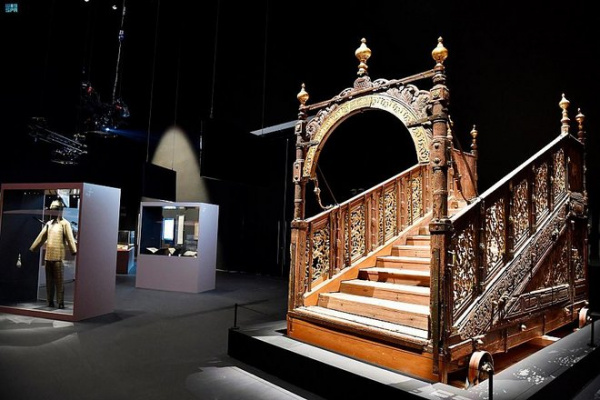The Islamic Art Exhibition at First House (Biennale of Islamic Art 2023), which is being held at the Western Pilgrims’ Hall at King Abdulaziz International Airport in Jeddah, Saudi Arabia, continues to receive visitors.
The exhibition includes 600 artifacts from the rarest manuscripts collected in museums around the world. The biennale is taking place over an area of 100,000 square meters, of which around 70,000 square meters is devoted to the exhibition space, and has 5 halls.
In addition to the galleries dedicated to displaying items from Mecca Al Muqarram and Al Madina Al Munawar, the terminal has an open space under umbrella tents, the Pilgrims’ Hall, which also displays artwork.
What makes this exhibition unique? Apart from works of art by contemporary artists, it features rare historical exhibits.
The Staircase to the Kaaba Door at the Jeddah Exhibition

Photo: aleqt.com
Country of origin is Hijaz or India, date of manufacture 1240 AH/1825 AD. The staircase was often installed near the Bani Shaiba and Zamzam gates. It is made of Indian teak wood and was previously stored in the General Directorate of the Great Mosque and the Prophet’s Mosque in the Kingdom of Saudi Arabia.
Its decoration is dominated by Ottoman coloring, as well as Indian and Hijazi decorative elements. Above the first rung of the staircase the following phrase is inscribed, ‘He who lacks the greatest wealth, his servant ar-Raji Muhammad enlightened, on the date 1240 AH/1825 AD’. On its left side there is another phrase, ‘Your servant is enlightened’.
Two Candleholders
Nearly 100 years later, the Diriya Biennale has brought together two exhibits, a candleholder for the Prophet’s (may peace be upon him.) room, at Exhibition Hall 5, known as the Madara Pavilion.
One was kept in the Benaki Museum in Athens and the other one – in the Cairo Museum of Islamic Art. A candleholder came to Cairo courtesy of Antonio Benacchi, a well-known antiquities dealer and collector from Alexandria. He sold the candleholder to the House of Arab Antiquities, whose name was changed in 1951 to the Cairo Museum of Islamic Art.
The two candleholders were specially commissioned by the ruler of Egypt and Syria, Qaitbay. This Mamluk sultan was famous for his charitable activities. He was also known for his extensive architectural patronage. After a fire broke out in the Prophet’s (may peace be upon him) mosque in 1481, Sultan Qaitbay sent his craftsmen to restore it.
The candleholders for the room of the Prophet (may peace be upon him) were made of copper, a black organic material. There is a ribbon on the neck of each candleholder inscribing that the candleholder is dedicated to the tomb of the Messenger (may peace be upon him) and was donated by Sultan Al-Malik Al-Ashrafah Abi Al-Nasr Qaitbay. The time of the gift is the Holy Month of Ramadan 887 AH/ October/November 1482 A.D., and perhaps this time was not chosen randomly. The upper letters of the line are shaped like tweezers. This new style of Mamluk writing emerged during the era of Qaitbay. His interest in building and restoring places of worship contributed to the flourishing of the arts.
These two unique exhibits will delight biennale visitors at Jeddah Airport until April.
GSV "Russia - Islamic world"
Photo: biennale.org.sa
